Calculus AB and Calculus BC
CHAPTER 3 Differentiation
Practice Exercises
Part A. Directions: Answer these questions without using your calculator.
In each of Questions 1–20 a function is given. Choose the alternative that is the derivative, ![]() of the function.
of the function.
1. y = x5 tan x
(A) 5x4 tan x
(B) x5 sec2 x
(C) 5x4 sec2 x
(D) 5x4 + sec2 x
(E) 5x4 tan x + x5 sec2 x
2. ![]()
(A) ![]()
(B) ![]()
(C) ![]()
(D) ![]()
(E) ![]()
3. ![]()
(A) ![]()
(B) ![]()
(C) ![]()
(D) ![]()
(E) ![]()
4. ![]()
(A) ![]()
(B) −30(5x + 1)−4
(C) ![]()
(D) ![]()
(E) ![]()
5. y = 3x2/3 − 4x1/2 − 2
(A) 2x1/3 − 2x−1/2
(B) 3x−1/3 − 2x−1/2
(C) ![]()
(D) ![]()
(E) 2x−1/3 − 2x−1/2
6. ![]()
(A) ![]()
(B) x−1/2 + x−3/2
(C) ![]()
(D) ![]()
(E) ![]()
7. ![]()
(A) ![]()
(B) 4y(x + 1)
(C) ![]()
(D) ![]()
(E) none of these
8. ![]()
(A) ![]()
(B) ![]()
(C) ![]()
(D) ![]()
(E) ![]()
9. ![]()
(A) ![]()
(B) ![]()
(C) ![]()
(D) 0
(E) ![]()
10. y = tan−1 ![]()
(A) ![]()
(B) ![]()
(C) ![]()
(D) ![]()
(E) ![]()
11. y = ln (sec x + tan x)
(A) sec x
(B) ![]()
(C) ![]()
(D) ![]()
(E) ![]()
12. ![]()
(A) 0
(B) 1
(C) ![]()
(D) ![]()
(E) ![]()
13. ![]()
(A) ![]()
(B) ![]()
(C) ![]()
(D) ![]()
(E) ![]()
14. ![]()
(A) ![]()
(B) ![]()
(C) ![]()
(D) ![]()
(E) cos (ln x)
15. ![]()
(A) −csc 2x cot 2x
(B) ![]()
(C) −4 csc 2x cot 2x
(D) ![]()
(E) −csc2 2x
16. y = e−x cos 2x
(A) −e−x (cos 2x + 2 sin 2x)
(B) e−x (sin 2x − cos 2x)
(C) 2e−x sin 2x
(D) −e−x (cos 2x + sin 2x)
(E) −e−x sin 2x
17. y = sec2 (x)
(A) 2 sec x
(B) 2 sec x tan x
(C) 2 sec2 x tan x
(D) sec2 x tan2 x
(E) tan x
18. y = x ln3 x
(A) ![]()
(B) 3 ln2 x
(C) 3x ln2 x + ln3 x
(D) 3(ln x + 1)
(E) none of these
19. ![]()
(A) ![]()
(B) ![]()
(C) ![]()
(D) ![]()
(E) ![]()
20. y = sin−1 ![]()
(A) ![]()
(B) ![]()
(C) ![]()
(D) ![]()
(E) ![]()
In each of Questions 21–24, y is a differentiable function of x. Choose the alternative that is the derivative ![]()
21. x3 − y3 = 1
(A) x
(B) 3x2
(C) ![]()
(D) ![]()
(E) ![]()
22. x + cos(x + y) = 0
(A) csc(x + y) − 1
(B) csc(x + y)
(C) ![]()
(D) ![]()
(E) ![]()
23. sin x − cos y − 2 = 0
(A) −cot x
(B) −cot y
(C) ![]()
(D) −csc y cos x
(E) ![]()
24. 3x2 − 2xy + 5y2 = 1
(A) ![]()
(B) ![]()
(C) 3x + 5y
(D) ![]()
(E) none of these
25. If x = t2 + 1 and y = 2t3, then ![]()
(A) 3t
(B) 6t2
(C) ![]()
(D) ![]()
(E) ![]()
BC ONLY
26. If f (x) = x4 − 4x3 + 4x2 − 1, then the set of values of x for which the derivative equals zero is
(A) {1,2}
(B) {0,−1,−2}
(C) {−1, + 2}
(D) {0}
(E) {0,1,2}
27. If f (x) = ![]() then f ″(4) is equal to
then f ″(4) is equal to
(A) −32
(B) −16
(C) −4
(D) −2
(E) ![]()
28. If f (x) = ln x3 then f ″(3) is
(A) ![]()
(B) −1
(C) −3
(D) 1
(E) none of these
29. If a point moves on the curve x2 + y2 = 25, then, at (0,5), ![]() is
is
(A) 0
(B) ![]()
(C) −5
(D) ![]()
(E) nonexistent
30. If x = t2 − 1 and y = t4 − 2t3, then, when t = 1, ![]() is
is
(A) 1
(B) −1
(C) 0
(D) 3
(E) ![]()
BC ONLY
31. If f (x) = 5x and 51.002 ![]() 5.016, which is closest to f ′(1)?
5.016, which is closest to f ′(1)?
(A) 0.016
(B) 1.0
(C) 5.0
(D) 8.0
(E) 32.0
32. If y = ex (x − 1), then y ″(0) equals
(A) −2
(B) −1
(C) 0
(D) 1
(E) none of these
33. If x = eθ cos θ and y = eθ sin θ, then, when ![]() is
is
(A) 1
(B) 0
(C) eπ/2
(D) nonexistent
(E) −1
BC ONLY
34. If x = cos t and y = cos 2t, then ![]() is
is
(A) 4 cos t
(B) 4
(C) ![]()
(D) −4
(E) −4 cot t
BC ONLY
35. ![]()
(A) 0
(B) 1
(C) 6
(D) ∞
(E) nonexistent
36. ![]()
(A) 0
(B) ![]()
(C) 1
(D) 192
(E) ∞
37. ![]()
(A) 0
(B) ![]()
(C) 1
(D) e
(E) nonexistent
38. ![]()
(A) −1
(B) 0
(C) 1
(D) ∞
(E) none of these
39.  which of these statements are true?
which of these statements are true?
I. ![]() exists.
exists.
II. f is continuous at x = 1.
III. f is differentiable at x = 1.
(A) none
(B) I only
(C) I and II only
(D) I and III only
(E) I, II, and III
40. ![]() which of these statements are true?
which of these statements are true?
I. ![]() exists.
exists.
II. g is continuous at x = 3.
III. g is differentiable at x = 3.
(A) I only
(B) II only
(C) III only
(D) I and II only
(E) I, II, and III
41. The function f (x) = x2/3 on [−8, 8] does not satisfy the conditions of the Mean Value Theorem because
(A) f (0) is not defined
(B) f (x) is not continuous on [−8, 8]
(C) f ′(−1) does not exist
(D) f (x) is not defined for x < 0
(E) f ′(0) does not exist
42. If f (x) = 2x3 − 6x, at what point on the interval 0 ≤ x ≤ ![]() if any, is the tangent to the curve parallel to the secant line on that interval?
if any, is the tangent to the curve parallel to the secant line on that interval?
(A) 1
(B) −1
(C) ![]()
(D) 0
(E) nowhere
43. If h is the inverse function of f and if ![]() then h ′(3) =
then h ′(3) =
(A) −9
(B) ![]()
(C) ![]()
(D) 3
(E) 9
44. ![]() equals
equals
(A) 0
(B) 1
(C) ![]()
(D) ∞
(E) none of these
BC ONLY
45. If sin(xy) = x, then ![]()
(A) sec(xy)
(B) ![]()
(C) ![]()
(D) ![]()
(E) sec(xy) − 1
46. ![]()
(A) 1
(B) 2
(C) ![]()
(D) 0
(E) ∞
47. ![]()
(A) 1
(B) ![]()
(C) ![]()
(D) 0
(E) nonexistent
48. ![]()
(A) nonexistent
(B) 1
(C) 2
(D) ∞
(E) none of these
49. ![]()
(A) ![]()
(B) 0
(C) 1
(D) π
(E) ∞
50. ![]()
(A) is 1
(B) is 0
(C) is ∞
(D) oscillates between −1 and 1
(E) is none of these
51. The graph in the xy-plane represented by x = 3 + 2 sin t and y = 2 cos t − 1, for −π ≤ t ≤ π, is
(A) a semicircle
(B) a circle
(C) an ellipse
(D) half of an ellipse
(E) a hyperbola
BC ONLY
52. ![]() equals
equals
(A) 0
(B) ![]()
(C) 1
(D) 2
(E) none of these
In each of Questions 53–56 a pair of equations that represent a curve parametrically is given. Choose the alternative that is the derivative ![]()
53. x = t − sin t and y = 1 − cos t
(A) ![]()
(B) ![]()
(C) ![]()
(D) ![]()
(E) ![]()
BC ONLY
54. x = cos3 θ and y = sin3 θ
(A) tan3 θ
(B) −cot θ
(C) cot θ
(D) −tan θ
(E) −tan2 θ
BC ONLY
55. x = 1 − e−t and y = t + e−t
(A) ![]()
(B) e−t − 1
(C) et + 1
(D) et − e−2t
(E) et − 1
56. ![]() and y = 1 − ln(1 − t) (t < 1)
and y = 1 − ln(1 − t) (t < 1)
(A) ![]()
(B) t − 1
(C) ![]()
(D) ![]()
(E) 1 + ln x
Part B. Directions: Some of the following questions require the use of a graphing calculator.
In Questions 57–64, differentiable functions f and g have the values shown in the table.
|
x |
f |
f ′ |
g |
g ′ |
|
0 |
2 |
1 |
5 |
−4 |
|
1 |
3 |
2 |
3 |
−3 |
|
2 |
5 |
3 |
1 |
−2 |
|
3 |
10 |
4 |
0 |
−1 |
57. If A = f + 2g, then A ′(3) =
(A) −2
(B) 2
(C) 7
(D) 8
(E) 10
58. If B = f · g, then B ′(2) =
(A) −20
(B) −7
(C) −6
(D) −1
(E) 13
59. If ![]() then D ′(1) =
then D ′(1) =
(A) ![]()
(B) ![]()
(C) ![]()
(D) ![]()
(E) ![]()
60. If H(x) = ![]() then H ′(3) =
then H ′(3) =
(A) ![]()
(B) ![]()
(C) 2
(D) ![]()
(E) ![]()
61. If K(x) = ![]() then K ′(0) =
then K ′(0) =
(A) ![]()
(B) ![]()
(C) ![]()
(D) ![]()
(E) ![]()
62. If M(x) = f (g(x)), then M ′(1) =
(A) −12
(B) −6
(C) 4
(D) 6
(E) 12
63. If P(x) = f (x3), then P ′(1) =
(A) 2
(B) 6
(C) 8
(D) 12
(E) 54
64. If S(x) = f −1(x), then S ′(3) =
(A) −2
(B) ![]()
(C) ![]()
(D) ![]()
(E) 2
65. The graph of g ′ is shown here. Which of the following statements is (are) true of g at x = a ?
I. g is continuous.
II. g is differentiable.
III. g is increasing.
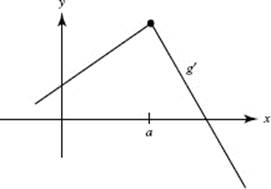
(A) I only
(B) III only
(C) I and III only
(D) II and III only
(E) I, II, and III
66. A function f has the derivative shown. Which of the following statements must be false?
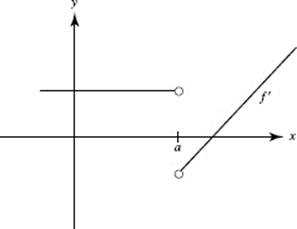
(A) f is continuous at x = a.
(B) f (a) = 0.
(C) f has a vertical asymptote at x = a.
(D) f has a jump discontinuity at x = a.
(E) f has a removable discontinuity at x = a.
67. The function f whose graph is shown has f ′ = 0 at x =
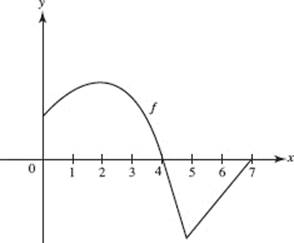
(A) 2 only
(B) 2 and 5
(C) 4 and 7
(D) 2, 4, and 7
(E) 2, 4, 5, and 7
68. A differentiable function f has the values shown. Estimate f ′(1.5).
|
x |
1.0 |
1.2 |
1.4 |
1.6 |
|
f (x) |
8 |
10 |
14 |
22 |
(A) 8
(B) 12
(C) 18
(D) 40
(E) 80
69. Water is poured into a conical reservoir at a constant rate. If h(t) is the rate of change of the depth of the water, then h is
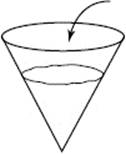
(A) constant
(B) linear and increasing
(C) linear and decreasing
(D) nonlinear and increasing
(E) nonlinear and decreasing
Use the figure to answer Questions 70–72. The graph of f consists of two line segments and a semicircle.
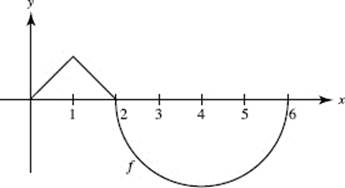
70. f ′(x) = 0 for x =
(A) 1 only
(B) 2 only
(C) 4 only
(D) 1 and 4
(E) 2 and 6
71. f ′(x) does not exist for x =
(A) 1 only
(B) 2 only
(C) 1 and 2
(D) 2 and 6
(E) 1, 2, and 6
72. f ′(5) =
(A) ![]()
(B) ![]()
(C) 1
(D) 2
(E) ![]()
73. At how many points on the interval [−5,5] is a tangent to y = x + cos x parallel to the secant line?
(A) none
(B) 1
(C) 2
(D) 3
(E) more than 3
74. From the values of f shown, estimate f ′(2).
|
x |
1.92 |
1.94 |
1.96 |
1.98 |
2.00 |
|
f (x) |
6.00 |
5.00 |
4.40 |
4.10 |
4.00 |
(A) −0.10
(B) −0.20
(C) −5
(D) −10
(E) −25
75. Using the values shown in the table for Question 74, estimate (f −1) ′(4).
(A) −0.2
(B) −0.1
(C) −5
(D) −10
(E) −25
76. The “left half” of the parabola defined by y = x2 − 8x + 10 for x ≤ 4 is a one-to-one function; therefore its inverse is also a function. Call that inverse g. Find g ′(3).
(A) ![]()
(B) ![]()
(C) ![]()
(D) ![]()
(E) ![]()
77. The table below shows some points on a function f that is both continuous and differentiable on the closed interval [2,10].
|
x |
2 |
4 |
6 |
8 |
10 |
|
f (x) |
30 |
25 |
20 |
25 |
30 |
Which must be true?
(A) f (x) > 0 for 2 < x < 10
(B) f ′(6) = 0
(C) f ′(8) > 0
(D) The maximum value of f on the interval [2,10] is 30.
(E) For some value of x on the interval [2,10] f ′(x) = 0.
78. If f is differentiable and difference quotients overestimate the slope of f at x = a for all h > 0, which must be true?
(A) f ′(a) > 0
(B) f ′(a) < 0
(C) f ″(a) > 0
(D) f ″(a) < 0
(E) none of these
79. If f (u) = sin u and u = g(x) = x2 − 9, then (f ° g) ′(3) equals
(A) 0
(B) 1
(C) 6
(D) 9
(E) none of these
80. If ![]() then the set of x’s for which f ′(x) exists is
then the set of x’s for which f ′(x) exists is
(A) all reals
(B) all reals except x = 1 and x = −1
(C) all reals except x = −1
(D) all reals except ![]() and x = −1
and x = −1
(E) all reals except x = 1
81. If ![]() then the derivative of y2 with respect to x2 is
then the derivative of y2 with respect to x2 is
(A) 1
(B) ![]()
(C) ![]()
(D) ![]()
(E) ![]()
BC ONLY
82. If y = x2 + x, then the derivative of y with respect to ![]() is
is
(A) (2x + 1)(x − 1)2
(B) ![]()
(C) 2x + 1
(D) ![]()
(E) none of these
BC ONLY
83. If ![]() and g(x) =
and g(x) = ![]() then the derivative of f (g(x)) is
then the derivative of f (g(x)) is
(A) ![]()
(B) −(x + 1)−2
(C) ![]()
(D) ![]()
(E) ![]()
84. If f (a) = f (b) = 0 and f (x) is continuous on [a, b], then
(A) f (x) must be identically zero
(B) f ′(x) may be different from zero for all x on [a, b]
(C) there exists at least one number c, a < c < b, such that f ′(c) = 0
(D) f ′(x) must exist for every x on (a, b)
(E) none of the preceding is true
85. Suppose y = f (x) = 2x3 − 3x. If h(x) is the inverse function of f, then h ′(−1) =
(A) −1
(B) ![]()
(C) ![]()
(D) 1
(E) 3
86. Suppose f (1) = 2, f ′(1) = 3, and f ′(2) = 4. Then (f −1) ′(2)
(A) equals ![]()
(B) equals ![]()
(C) equals ![]()
(D) equals ![]()
(E) cannot be determined
87. If f (x) = x3 − 3x2 + 8x + 5 and g(x) = f −1(x), then g ′(5) =
(A) 8
(B) ![]()
(C) 1
(D) ![]()
(E) 53
88. Suppose ![]() It follows necessarily that
It follows necessarily that
(A) g is not defined at x = 0
(B) g is not continuous at x = 0
(C) the limit of g(x) as x approaches 0 equals 1
(D) g ′(0) = 1
(E) g ′(1) = 0
Use this graph of y = f (x) for Questions 89 and 90.
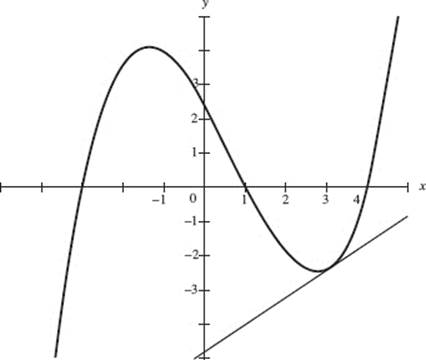
89. f ′(3) is most closely approximated by
(A) 0.3
(B) 0.8
(C) 1.5
(D) 1.8
(E) 2
90. The rate of change of f (x) is least at x ![]()
(A) −3
(B) −1.3
(C) 0
(D) 0.7
(E) 2.7
Use the following definition of the symmetric difference quotient for f ′ (x0) for Questions 91–93: For small values of h,
![]()
91. For f (x) = 5x, what is the estimate of f ′(2) obtained by using the symmetric difference quotient with h = 0.03?
(A) 25.029
(B) 40.236
(C) 40.252
(D) 41.223
(E) 80.503
92. To how many places is the symmetric difference quotient accurate when it is used to approximate f ′(0) for f (x) = 4x and h = 0.08?
(A) 1
(B) 2
(C) 3
(D) 4
(E) more than 4
93. To how many places is f ′(x0) accurate when it is used to approximate f ′(0) for f (x) = 4x and h = 0.001?
(A) 1
(B) 2
(C) 3
(D) 4
(E) more than 4
94. The value of f ′(0) obtained using the symmetric difference quotient with f (x) = |x| and h = 0.001 is
(A) −1
(B) 0
(C) ±1
(D) 1
(E) indeterminate
95. If ![]() and h(x) = sin x, then
and h(x) = sin x, then ![]() equals
equals
(A) g(sin x)
(B) cos x · g(x)
(C) g ′(x)
(D) cos x · g (sin x)
(E) sin x · g(sin x)
96. Let f (x) = 3x − x3. The tangent to the curve is parallel to the secant through (0,1) and (3,0) for x =
(A) 0.984 only
(B) 1.244 only
(C) 2.727 only
(D) 0.984 and 2.804 only
(E) 1.244 and 2.727 only
Questions 97–101 are based on the following graph of f (x), sketched on −6 ≤ x ≤ 7. Assume the horizontal and vertical grid lines are equally spaced at unit intervals.
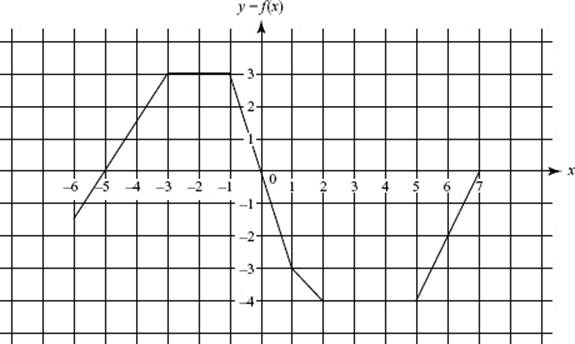
97. On the interval 1 < x < 2, f (x) equals
(A) −x − 2
(B) −x − 3
(C) −x − 4
(D) −x + 2
(E) x − 2
98. Over which of the following intervals does f ′(x) equal zero?
I. (−6,−3)
II. (−3,−1)
III. (2,5)
(A) I only
(B) II only
(C) I and II only
(D) I and III only
(E) II and III only
99. How many points of discontinuity does f ′(x) have on the interval −6 < x < 7?
(A) none
(B) 2
(C) 3
(D) 4
(E) 5
100. For −6 < x < −3, f ′(x) equals
(A) ![]()
(B) −1
(C) 1
(D) ![]()
(E) 2
101. Which of the following statements about the graph of f ′(x) is false?
(A) It consists of six horizontal segments.
(B) It has four jump discontinuities.
(C) f ′(x) is discontinuous at each x in the set {−3,−1,1,2,5}.
(D) f ′(x) ranges from −3 to 2.
(E) On the interval −1 < x < 1, f ′(x) = −3.
102. The table gives the values of a function f that is differentiable on the interval [0,1]:
|
x |
0.10 |
0.20 |
0.30 |
0.40 |
0.50 |
0.60 |
|
f (x) |
0.171 |
0.288 |
0.357 |
0.384 |
0.375 |
0.336 |
According to this table, the best approximation of f ′(0.10) is
(A) 0.12
(B) 1.08
(C) 1.17
(D) 1.77
(E) 2.88
103. At how many points on the interval [a, b] does the function graphed satisfy the Mean Value Theorem?
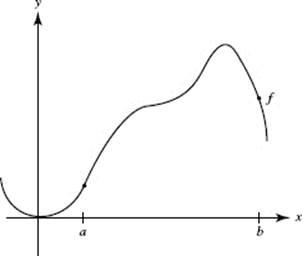
(A) none
(B) 1
(C) 2
(D) 3
(E) 4